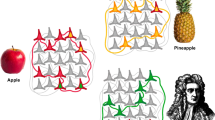Abstract
The present paper looks for possible neural mechanism underlying such high-level brain functioning as association and concept-formation. Primitive neural models of association and concept-formation are presented, which will elucidate the distributed and multiply superposed manner of retaining knowledge in the brain. The models are subject to two rules of self-organization of synaptic weights, orthogonal and covariance learning. The convergence of self-organization is proved, and the characteristics of these learning rules are shown. The performances, especially the noise immunity, of the association net and concept-formation net are analyzed.
Similar content being viewed by others
References
Albert, A.: Regression and the Moore-Penrose pseudoinverse. New York Academic Press 1972
Amari, S.: Characteristics of randomly connected threshold element networks and network systems. Proc. IEEE 59, 35–47 (1971)
Amari, S.: Learning patterns and pattern sequences by self-organizing nets of threshold elements. IEEE Trans. Comp. C-21, 1197–1206 (1972a)
Amari, S.: Characteristics of random nets of analog neuron-like elements. IEEE Trans. on Systems, Man, and Cybernetics SMC-2, 643–657 (1972b)
Amari, S.: A method of statistical neurodynamics. Kybernetik 14, 201–215 (1974a)
Amari, S.: A mathematical theory of nerve nets. In: Kotani, M. (Ed.): Advances in biophysics, Vol. 6, pp. 75–120. Tokyo: University Press 1974b
Amari, S.: Homogeneous nets of neuron-like elements. Biol. Cybernetics 17, 211–220 (1975)
Amari, S.: Dynamics of pattern formation in lateral-inhibition type neural fields. To be published (1977a)
Amari, S.: A mathematical approach to neural systems. In: Arbib, M. A., Metzler, J. (Eds.): Systems neuroscience. I. New York: Academic Press 1977b
Amari, S., Yoshida, K., Kanatani, K.: Mathematical foundation of statistical neurodynamics. SIAM J. Appl. Math. 33 (1977)
Anderson, J. A.: A simple neural networks generating interactive memory. Math. Biosc. 14, 197–220 (1972)
Caianiello, E. R.: Outline of a theory of thought processes and thinking machines. J. theor. Biol. 1, 204–235 (1961)
Grossberg, S.: Onlearning, information lateral inhibition, and transmitters. Math. Biosc. 4, 255–310 (1969)
Hebb D. O.: The organization of behavior. New York: Wiley 1949
Kohonen, T.: Correlation matrix memories. IEEE Trans. Comp. C-21, 353–359 (1972)
Kohonen, T.: An adaptive associative memory principle. IEEE Trans. Comp. C-23, 444–445 (1974)
Kohonen, T., Oja, E.: Fast adaptive formation pf orthogonalizing filters and associative memory in recurrent networks of neuron-like elements. Biol. Cybernetics 21, 85–95 (1976)
Malsburg von der, C.: Self-organization of orientation sensitive cells in the striate cortex. Kybernetik 14, 85–100 (1973)
Nakano, K.: Associatron—a model of associative memory. IEEE Trans.on Systems, Man, and Cybernetics SMC-2, 380–388 (1972)
Pfaffelhuber, E.: Correlation memory models—a first approximation in a general learning scheme. Biol. Cybernetics 18, 217–223 (1975)
Rosenblatt, F.: Principles of Neurodynamics. Washington: Spartan 1961
Spinelli, N.: OCCAM: a computer model for a content-addressable memory in the central nervous systems. Biology of memory 293–306. New York: Academic Press 1970
Uesaka, Y., Ozeki, K.: Some properties of association-type memories. JIEECE of Japan (in Japanese), 55-D, 323–330 (1972)
Wasan, M. T.: Stochastic approximation. Cambridge: University Press 1969
Wigström, H.: A neuron model with learning capability and its relation to mechanism of association. Kybernetik 12, 204–215 (1973)
Willshaw, D. J., Longuet-Higgins, H. C.: The holophone—recent developments. In: Metzler, B., Michie, D. (Eds.). Machine intelligence, Vol. 4, pp. 349–357. Edinburgh: University Press 1969
Author information
Authors and Affiliations
Additional information
This research was supported in part by a grant by the Sloan Foundation to the Center for Systems Neuroscience, University of Massachusetts
Rights and permissions
About this article
Cite this article
Amari, SI. Neural theory of association and concept-formation. Biol. Cybernetics 26, 175–185 (1977). https://doi.org/10.1007/BF00365229
Received:
Issue Date:
DOI: https://doi.org/10.1007/BF00365229




